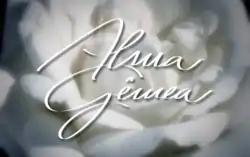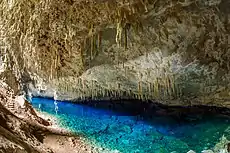Alma Gêmea
Alma Gêmea (English: Soul Mate) is a Brazilian telenovela produced and aired by Rede Globo from June 20, 2005 to March 10, 2006, in 227 episodes,[2] replacing Como uma Onda and being replaced by Sinhá Moça. Written by Walcyr Carrasco, in collaboration with Thelma Guedes, directed by Fred Mayrink and Pedro Vasconcelos and general direction and core direction by Jorge Fernando.
| Alma Gêmea | |
|---|---|
 | |
| Also known as | Soul Mate |
| Genre | Telenovela |
| Created by | Walcyr Carrasco |
| Written by | Thelma Guedes |
| Directed by | Jorge Fernando[1] |
| Starring |
|
| Theme music composer | Peninha |
| Opening theme | "Alma Gêmea" by Fábio Júnior |
| Country of origin | Brazil |
| Original language | Portuguese |
| No. of episodes | 227 |
| Production | |
| Production locations | Rio de Janeiro, Brazil |
| Camera setup | Multi-camera |
| Running time | 50 minutes |
| Release | |
| Original network | Rede Globo |
| Picture format | 480i (SDTV) |
| Audio format | Stereo |
| Original release | June 20, 2005 – March 10, 2006 |
In the main roles had Eduardo Moscovis, Priscila Fantin, Flávia Alessandra, Liliana Castro, Sidney Sampaio, Bia Seidl, Elizabeth Savalla and Ana Lúcia Torre.[3]
Production
Before the recording began, the telenovela cast and crew attended lectures with anthropologist Giovani José da Silva and Carlos Eduardo Sarmento, professor at the Getulio Vargas Foundation, respectively on indigenous culture and socioeconomic, cultural and political customs of the 1940s. In addition, the anthropologist gave indigenous language classes to Priscila Fantin, André Gonçalves, Francisco Carvalho, Maria Silvia, Julia Lemmertz and Thaíssa Ribeiro. These actors also had the guidance of prosody researcher Íris Gomes da Costa. Fernanda Souza, Emilio Orciollo Netto and Emiliano Queiroz took classes in redneck prosody with Silvia Nobre. Marcelo Barros gained notions of northeastern prosody. Liliana Castro took piano lessons from Claudia Castelo Branco and learned ballet steps from Cissa Rondinelli. Eduardo Moscovis went to Roselândia, in Cotia, São Paulo, to know the techniques of grafting and planting roses – on site there are over 300 species of rose bushes. Malvino Salvador trained in São Paulo restaurants the handling of culinary utensils and the manufacture of bread. To give life to villain Cristina, actress Flávia Alessandra watched horror, suspense, obsession and madness movies, looking for inspiration to compose the various stages of the character. The actress also dispensed with body double in the most difficult scenes. Alexandre Barillari visited Ary Franco Prison (Portuguese: Presídio Ary Franco) in Rio de Janeiro, where he talked with detainees to help with the composition of the villain Guto.
Scenography

Serena's scenes in the indigenous community – including her birth, her mother's death, her growth, the invasion and destruction of the village, until her departure to São Paulo – were filmed in locations such as Bonito, in Mato Grosso do Sul, Carrancas, in Minas Gerais, and the Camorim neighborhood, in Rio de Janeiro. In Bonito, the production of about 70 professionals was assisted by firefighters, army personnel and an abseiling team to transport the equipment. In Camorim, a scenographic village was built, basically made of straw and wood, with 13 ocas. There were scenes of the prospectors' invasion and the fire, which were attended by 80 background actors. Pieces of the village were used in the engravings in Bonito and Carrancas. The first recordings in São Paulo included scenes of Serena passing through historical sites of the city, such as Estação Júlio Prestes, Pinacoteca do Estado, Museu do Ipiranga and the São Paulo Cathedral, as well as scenes in the Vila dos Ingleses with about 20 extras actors.
The cinematic city of Roseiral built at Estúdios Globo (formerly Projac) was inspired by various locations, including São Paulo and Rio de Janeiro. Also used as references were cities in the interior of São Paulo, such as Bernardino de Campos and the hydromineral estancia Águas de Santa Barbara; and municipalities of Paraná, such as Castro, Morretes, Antonina and Lapa. Raised in an area of 9,000 square meters, Roseiral houses the houses of Rafael and Agnes, the residential building of Vera, the village of the Divina pension, as well as church, flower shop, pharmacy, train station, barber shop, grocery store, city hall, cinema, ice cream shop, doctor's office and shoemaker, some with inland. The greenhouse, one of the relevant scenarios of the telenovela, gained an outside in the scenographic city and inland in studio. This was one of the most laborious environments due to the maintenance of roses. The flowers had to be kept in a refrigerator at a temperature between eight and 12 degrees and could not be in stuffy places. Artificial roses were mixed with natural roses to make up the scenery.
Costume and characterization
The 1920s of the telenovela were characterized by straight-cut, waist-free costumes and flattened busts for women, and narrow, waist-length clothing with a tight-fitting trouser neck and a bowler hat for men. In the 1940s, the tone of Italian comedies of the early 1950s followed, with references, among others, to films by Italian filmmaker Federico Fellini. One of the highlights is Cristina, who used the colors red, purple and wine a lot, as a typical cartoon villain. Also had repercussion the composition of the character Kátia, by Rita Guedes, a mix of actresses Veronica Lake, Lana Turner and Rita Hayworth, and also the character Jessica Rabbit from the film Who Framed Roger Rabbit. The biggest difficulty encountered by the makeup team was the characterization of the Indians.
A special waterproof makeup was commissioned to make the painting resist the sweat of the recordings. Priscila Fantin had to darken her hair and straighten it every day. In the scenographic city, the actresses wore half wigs to differentiate between the two stages of the telenovela. Nicette Bruno and Walderez de Barros wore a gray wig in the 1940s.
Plagiarism accusations
In October 2005, Walcyr was accused of plagiarism by writer Carlos de Andrade, author of the book Chuva de Novembro. He filed a lawsuit demanding 10% of the telenovela's revenue and claiming it was a plagiarism of his book. Chuva de Novembro tells the story of musician Caio, who falls in love with Caressa, who gives a yellow rose. Cousin Regina becomes jealous and devises a plan to kill Caressa, making Caio live a lonely life. In the telenovela, the characters would be Rafael, Luna and Cristina.[4] A while later, writer Shirley Costa also accused Walcyr Carrasco of plagiarism; According to her, some details of scenes and the history of the telenovela were copied from her book Rosácea. The writer assured that the book came to the author. A first report confirmed the plagiarism action.[5] In April 2009, Carrasco was acquitted of the charge. The expert identified 185 points in common in both works, but claimed that he could not claim to be plagiarism.[6] In September of the same year, a few days after the telenovela began to be redisplayed, the writer appealed the decision and the process was reopened.[7] However, in January 2010, the plaintiff was again acquitted by the court. The judge concluded that "there was no plagiarism, since the comparative texts do not have identity points, original plot characteristics or creative technique." He further says that "similar points can be found in several other works such as Greek mythology, troubadour novels, Nibelung tales and children's literature.[8]
Cast
| Actor | Character |
|---|---|
| Priscila Fantin | Serena Anauê |
| Eduardo Moscovis | Rafael de Souza Dias |
| Flávia Alessandra | Cristina Ávilla Saboya Dias |
| Ana Lúcia Torre | Débora Ávilla Saboya |
| Alexandre Barillari | Augusto Casali (Guto) |
| Drica Moraes | Olívia Médici Siqueira |
| Malvino Salvador | Vitório Santini |
| Luigi Baricelli | Raul de Carvalho Siqueira |
| Fernanda Souza | Mirna Gonçalves da Silva |
| Emílio Orciollo Netto | Crispim Gonçalves da Silva |
| Cecília Dassi | Mirella de Médici Siqueira |
| Sidney Sampaio | Felipe Ávilla Blanco Dias |
| Kayky Brito | Gumercindo Parreira |
| Fernanda Machado | Dalila Santini |
| Rodrigo Phavanello | Roberval Silvério / Roberval Albuquerque |
| Nívea Stelmann | Alexandra Montenegro |
| Ângelo Antônio | Dr. Eduardo Montenegro |
| Bia Seidl | Vera Souza Dias |
| Marcelo Faria | Jorge Amadeu |
| Elizabeth Savalla | Agnes Ávilla Blanco |
| Walderez de Barros | Adelaide Ávilla |
| Neusa Maria Faro | Divina Santini |
| Fúlvio Stefanini | Osvaldo Santini |
| Nicette Bruno | Ofélia Santini |
| Rita Guedes | Kátia Dantas |
| Felipe Camargo | Dr. Julian Enke |
| Bruna di Tullio | Madalena |
| Erik Marmo | Hélio Santini |
| Aisha Jambo | Sabine Bel-Lac |
| Tammy Di Calafiori | Nina Santini |
| Andréa Avancini | Terezinha |
| Lady Francisco | Generosa |
| Marcelo Barros | Alaor |
| Thiago Luciano | Ivan dos Santos |
| Carla Daniel | Zulmira dos Santos |
| Ernesto Piccolo | Eurico |
| Emiliano Queiroz | Bernardo dos Santos (Tio Nardo) |
| Umberto Magnani | Elias |
| Rosane Gofman | Nair |
| Keruse Bongiolo | Judith |
| Michel Bercovitch | Ciro |
| Ronnie Marruda | Abílio Pedreira |
| Mariah da Penha | Clarice Pedreira |
| Hilda Rebello | Dona Filó |
| David Lucas | Terê Dias |
| Renan Ribeiro | Carlito de Médici Siqueira |
| Pamella Rodrigues | Paulina Pedreira |
| Caroline Smith | Ritinha |
Special guests
| Actor | Character |
|---|---|
| Liliana Castro | Luna Ávilla Blanco Dias |
| André Gonçalves | José Aristides Anauê |
| Rodrigo Faro | Zacarias |
| Luiz Gustavo | Romeu Albuquerque |
| Betty Faria | Marielza |
| Júlia Lemmertz | Professora Cleyde |
| Othon Bastos | Padre Álvaro |
| Louise Cardoso | Doralice |
| Thaíssa Carvalho | Aliena Anauê |
| Luciana Rigueira | Jacira Anauê |
| Marcos Suchara | Josias Anauê |
| Maria Silvia | Jaçuí Anuê |
| Alexandre Zacchia | Percival |
| Carolyna Aguiar | Mafalda |
| Carvalhinho | Padre |
| Castro Gonzaga | Marcelino |
| Daniel Barcellos | Dr. Ermelino |
| Duse Nacaratti | Feiticeira |
| Francisco Carvalho | Pajé José Anauê |
| Fred Mayrink | Cantor do Clube da Cidade de Roseiral |
| Ilva Niño | Almerinda |
| Jaime Leibovitch | Juíz |
| Carlos Gregório | Sr. Rodriguez |
| Luciano Vianna | Xavier |
| Jorge Cherques | Psiquiatra de Alexandra |
| Jorge Fernando | Papai Noel |
| José Augusto Branco | Argemiro |
| Júlio Braga | Contador de Dr. Santos |
| Mário Cardoso | Dr. Santos (Rafael's lawyer) |
| Maurício Machado | Baltazar Alvarim |
| Nina de Pádua | Eliete |
| Roberto Bataglin | Dr. Pandolfo |
| Ana Beatriz Braga | Serena (child) |
| Victor Hugo Cugula | José Aristides (child) |
| Haylton Faria | Delegado |
| Rômulo Medeiros | Padre |
| Adilson Girardi | Guarda |
Soundtrack
Alma Gêmea soundtrack has been released on two albums. The first album Alma Gêmea - Nacional, which contains 16 tracks, brings together songs in Portuguese language. Already in the second album (the international version) contains 14 tracks in various languages. The songs usually have a theme character in the telenovela.
Nacional
| Alma Gêmea - Nacional | |
|---|---|
 | |
| Soundtrack album by Various artists | |
| Released | 2005 |
| Genre | Various |
| Language | Portuguese |
| Label | Som Livre |
Track list
- "Índia" – Roberto Carlos
- "Quem sabe isso quer dizer amor "– Milton Nascimento
- "Um Segredo e um Amor" – Sandy
- "Margarida" – Roupa Nova
- "Alma Gêmea" – Fábio Júnior
- "Eterno Amor (True Love)" – Cídia e Daniel
- "Uma vez mais" – Ivo Pessoa
- "Diz nos meus olhos (Inclemência)" – Zélia Duncan
- "Eu não existo sem você" – Maria Bethânia
- "Linda flor (Yayá) (AI, YOUO)" – Gal Costa
- "A Vida que a gente leva" – Leila Pinheiro
- "Estrada do Sertão" – Elba Ramalho
- "Todo seu querer" – Raimundo Fagner
- "Um Sonho de Verão (Moonlight Serenade)" – Jussara Silveira
- "Acidente de Amor" – Gino & Geno
- "Suíte dos Índios" – Mú Carvalho
Internacional
| Alma Gêmea - Internacional | |
|---|---|
 | |
| Soundtrack album by Various artists | |
| Released | 2005 |
| Genre | Various |
| Language |
|
| Label | Som Livre |
Track list
- "My Funny Valentine" – Rod Stewart
- "Moonlight Serenade" – Carly Simon
- "Mr. Lonely" – Fabianno
- "La Vie En Rose" – Strings Orchestra
- "Amapola" – The Royal Philharmonic Orchestra
- "Al Di Là" – Paolo
- "Fly Me to the Moon (In Other Words)" – Peter Jones
- "Blue Moon" – SNZ
- "Misty" – Ivo Pessoa
- "The Lovers (Prelude)" – John K. Steffen
- "At Last" – Kenny G featuring Arturo Sandoval
- "Sway (Quien Será)" – Dean Martin
- "Frenesí" – Montserrat (Comic scenes' theme)
- "Mambo Nº8" – Mambo Project
International transmission
Alma Gêmea premiered on Portuguese broadcaster SIC about a month after its debut on TV Globo. In 2007, TV Globo Internacional announced the signing of a contract with Pappas Telecasting – a network of local stations in the western United States – to broadcast the telenovela. Unpublished in the United States, the telenovela began to be broadcast in the country, in Hispanic version, from July 2, at 7 pm. On August 13, 2007, the telenovela premiered in Costa Rica, aired by the Teletica channel. Successful in the international market, the telenovela was shown in countries such as Russia, Peru and Venezuela.[9]
References
- Memória Globo. "Alma Gêmea - Trama Principal". Retrieved 18 January 2014.
- Memória Globo. "Alma Gêmea - Ficha Técnica". Retrieved 21 December 2008.
- "Alma Gêmea – Galeria de personagem". Memória Globo. Archived from the original on 4 February 2014. Retrieved 30 October 2015.
- "Justiça: Alma Gêmea acusado de plágio por escritor". Estrelando. 25 October 2005.
- "Walcyr Carrasco é acusado de plagiar livro em novela". UOL. 26 December 2007. Retrieved 12 August 2014.
- "Alma Gêmea: Walcyr Carrasco se livra de acusação de plágio". 180 graus. Retrieved 12 August 2014.
- "Três autores acusam novela da Globo de plágio, diz coluna". Área Vip. Archived from the original on 13 July 2015. Retrieved 12 August 2014.
- "Walcyr Carrasco é absolvido novamente em acusação de plágio". Diário do Grande ABC. 26 January 2010. Retrieved 12 August 2014.
- "Alma Gêmea - Curiosidades". Memória Globo. Globo.com. Retrieved 12 July 2014.
External links
- Alma Gemea (in Portuguese) on Memória Globo
- Alma Gêmea at IMDb